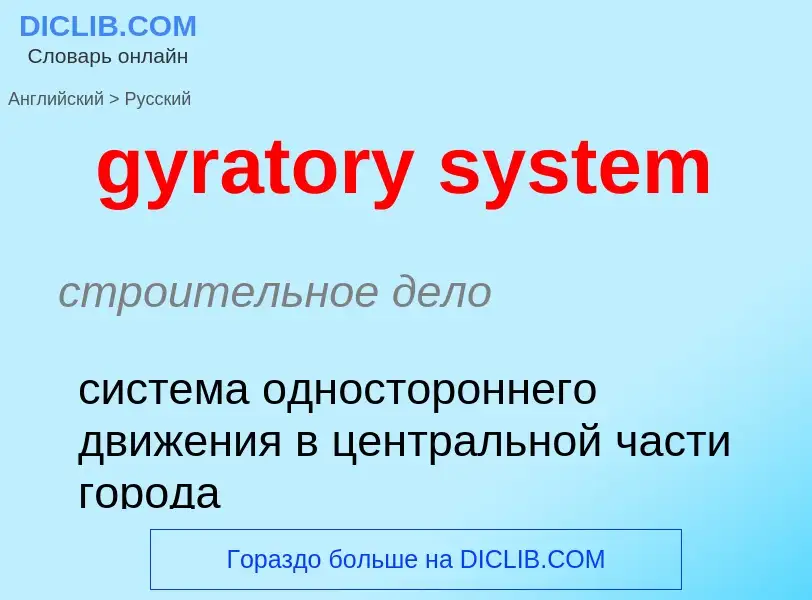Перевод и анализ слов искусственным интеллектом ChatGPT
На этой странице Вы можете получить подробный анализ слова или словосочетания, произведенный с помощью лучшей на сегодняшний день технологии искусственного интеллекта:
- как употребляется слово
- частота употребления
- используется оно чаще в устной или письменной речи
- варианты перевода слова
- примеры употребления (несколько фраз с переводом)
- этимология
gyratory system - перевод на русский
строительное дело
система одностороннего движения в центральной части города
Википедия

A roundabout, also known as a rotary or traffic circle, is a type of circular intersection or junction in which road traffic is permitted to flow in one direction around a central island, and priority is typically given to traffic already in the junction.
Engineers use the term modern roundabout to refer to junctions installed after 1960 that incorporate various design rules to increase safety. Compared to stop signs, traffic signals, and earlier forms of roundabouts, modern roundabouts reduce the likelihood and severity of collisions greatly by reducing traffic speeds and minimizing T-bone and head-on collisions. Variations on the basic concept include integration with tram or train lines, two-way flow, higher speeds and many others.
For pedestrians, traffic exiting the roundabout comes from one direction, instead of three, simplifying the pedestrian's visual environment. Traffic moves slowly enough to allow visual engagement with pedestrians, encouraging deference towards them. Other benefits include reduced driver confusion associated with perpendicular junctions and reduced queuing associated with traffic lights. They allow U-turns within the normal flow of traffic, which often are not possible at other forms of junction. Moreover, since vehicles that run on gasoline averagely spend less time idling at roundabouts than at signalled intersections, using a roundabout potentially leads to less pollution. When entering vehicles only need to give way, they do not always perform a full stop; as a result, by keeping a part of their momentum, the engine will produce less work to regain the initial speed, resulting in lower emissions. Research has also shown that slow-moving traffic in roundabouts makes less noise than traffic that must stop and start, speed up and brake.
Modern roundabouts were first standardised in the UK in 1966 and were found to be a significant improvement over previous traffic circles and rotaries. Since then, modern roundabouts have become commonplace throughout the world,: 2 including Australia, the United Kingdom and France.


![French]]. In the middle of the roundabout is the [[Arc de Triomphe]]. French]]. In the middle of the roundabout is the [[Arc de Triomphe]].](https://commons.wikimedia.org/wiki/Special:FilePath/ARC DE TRIOMPHE.png?width=200)
![Blenheim]], New Zealand. Blenheim]], New Zealand.](https://commons.wikimedia.org/wiki/Special:FilePath/Blenheim Main Street Roundabout looking north (LCM20210404).jpg?width=200)
![A30]] in [[Cornwall]], United Kingdom. There is a free-flow lane for the A30 towards [[Bodmin]] (nearest the camera). A30]] in [[Cornwall]], United Kingdom. There is a free-flow lane for the A30 towards [[Bodmin]] (nearest the camera).](https://commons.wikimedia.org/wiki/Special:FilePath/CarlandCrossRoundaboutA30Cornwall.jpg?width=200)


![A roundabout next to the Elovainio shopping centre in [[Ylöjärvi]], Finland A roundabout next to the Elovainio shopping centre in [[Ylöjärvi]], Finland](https://commons.wikimedia.org/wiki/Special:FilePath/Elovainio shopping center roundabout - panoramio.jpg?width=200)
![A fountain dominates this roundabout in [[Aix-en-Provence]], France. A fountain dominates this roundabout in [[Aix-en-Provence]], France.](https://commons.wikimedia.org/wiki/Special:FilePath/La fontaine des trois Grâces, 1860.jpg?width=200)
![The United Kingdom's first roundabout (1909) in [[Letchworth Garden City]] The United Kingdom's first roundabout (1909) in [[Letchworth Garden City]]](https://commons.wikimedia.org/wiki/Special:FilePath/Letchworth Roundabout 1909.jpg?width=200)
![A major signal-controlled roundabout interchange in central [[Bristol]], England. Vehicles drive on the left, and vehicles in the roundabout are stopped by traffic lights to allow other vehicles to enter, while an [[underpass]] permits straight-through traffic to bypass the roundabout entirely. A major signal-controlled roundabout interchange in central [[Bristol]], England. Vehicles drive on the left, and vehicles in the roundabout are stopped by traffic lights to allow other vehicles to enter, while an [[underpass]] permits straight-through traffic to bypass the roundabout entirely.](https://commons.wikimedia.org/wiki/Special:FilePath/Old Market Roundabout, Bristol.jpg?width=200)
![Motorway junction with roundabout near [[Opatovice nad Labem]], Czech Republic Motorway junction with roundabout near [[Opatovice nad Labem]], Czech Republic](https://commons.wikimedia.org/wiki/Special:FilePath/Opatovice nad Labem kruhový objezd from air K2 -1.jpg?width=200)
![Near [[Nationaltheatret]] in [[Oslo]], [[tram]]ways cross the roundabout Near [[Nationaltheatret]] in [[Oslo]], [[tram]]ways cross the roundabout](https://commons.wikimedia.org/wiki/Special:FilePath/Trams at Nationaltheatret.jpg?width=200)
![left-hand traffic]]; note the [[clockwise]] circulation left-hand traffic]]; note the [[clockwise]] circulation](https://commons.wikimedia.org/wiki/Special:FilePath/UK Roundabout 8 Cars.gif?width=200)
![This roundabout in [[Shanghai]], China, has a pedestrian bridge in the form of another, raised roundabout. This roundabout in [[Shanghai]], China, has a pedestrian bridge in the form of another, raised roundabout.](https://commons.wikimedia.org/wiki/Special:FilePath/View2FromPearlTower.jpg?width=200)
![A small roundabout in [[Waterloo, Ontario]], Canada A small roundabout in [[Waterloo, Ontario]], Canada](https://commons.wikimedia.org/wiki/Special:FilePath/Waterloo, Ontario, mini-roundabout at Union Street East and Margaret Avenue South.jpg?width=200)

![Traffic ten abreast traverses the ''[[Place de l'Étoile]]''. This traffic circle surrounds the ''[[Arc de Triomphe]]'' at the intersection of ten two-way and two one-way streets. It has no lane markings. Traffic ten abreast traverses the ''[[Place de l'Étoile]]''. This traffic circle surrounds the ''[[Arc de Triomphe]]'' at the intersection of ten two-way and two one-way streets. It has no lane markings.](https://commons.wikimedia.org/wiki/Special:FilePath/Place Charles-de-Gaulle from the Arc de Triomphe, July 2001.jpg?width=200)
![Roundabout in [[Straßwalchen]], Austria Roundabout in [[Straßwalchen]], Austria](https://commons.wikimedia.org/wiki/Special:FilePath/Straßwalchen kreisverkehr 2.jpg?width=200)
![Double-lane Raindrop Fountain Roundabout in [[Zenica]], Bosnia and Herzegovina, where roundabouts replaced all traffic lights since 2011. Double-lane Raindrop Fountain Roundabout in [[Zenica]], Bosnia and Herzegovina, where roundabouts replaced all traffic lights since 2011.](https://commons.wikimedia.org/wiki/Special:FilePath/Зеница 20180730 175900.jpg?width=200)
![The [[Hovenring]] bicycle roundabout in the Netherlands is an innovative design, completely separating bicycles from vehicular traffic. The [[Hovenring]] bicycle roundabout in the Netherlands is an innovative design, completely separating bicycles from vehicular traffic.](https://commons.wikimedia.org/wiki/Special:FilePath/Fietsotonde Hovenring Eindhoven.jpg?width=200)
![Pavement markings invite cyclists to enter sidewalk on approach to roundabout in [[Mesa, Arizona]]. Cyclists are still permitted to use the roundabout like any other vehicle. Pavement markings invite cyclists to enter sidewalk on approach to roundabout in [[Mesa, Arizona]]. Cyclists are still permitted to use the roundabout like any other vehicle.](https://commons.wikimedia.org/wiki/Special:FilePath/Okay to enter sidewalk.jpg?width=200)

![Swindon Magic Roundabout]] Swindon Magic Roundabout]]](https://commons.wikimedia.org/wiki/Special:FilePath/Magic Roundabout Schild db.jpg?width=200)


